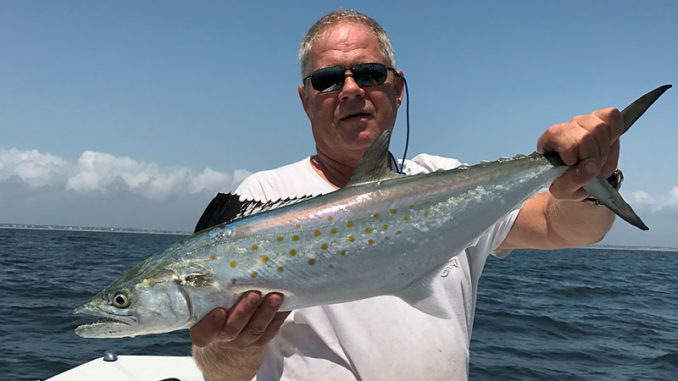
Spanish mackerel are a favorite among N.C. anglers
Spanish mackerel arrive off North Carolina’s southern coast in late April or early May and stay until the water cools in the fall. These smaller mackerel are always welcome, as they are usually feeding, are willing biters and have a pleasing, mild flavor.
Anglers eagerly await the spring arrival of Spanish macks. But they anticipate the fall bite even more highly. After feeding hard all summer, they are larger, fight harder and still hit the taste buds just right. They are a favorite on the line and in the frying pan.
Fall Spanish mackerel often feed just beyond the breakers. A seemingly endless line of mullet minnows heading south lures them there. This puts them in the fishing range of almost everyone, occasionally even including surf casters.
Spanish macks are very popular with boat fishermen and are often found just outside the inlets. They catch Spanish by trolling small, flashy spoons, slow-trolling or drifting small, live baits or by casting jigs to feeding fish. Unfortunately not everyone has a boat.
Pier anglers catch lots of Spanish
Pier fishing is available to everyone, and pier Spanish catches can be excellent. The Cape Fear region boasts seven public fishing piers. So this action is available from Wrightsville Beach to Sunset Beach. For a daily, weekly or seasonal fee, fishermen can use the piers to gain access to roughly the first 1,000 feet of the ocean. And this is usually where the larger fall Spanish roam.
Carolyn Riggan at Oak Island Pier in Oak Island, said, “Our fishermen caught some nice Spanish during the spring run. And we’re looking at the fall run to be even better.
“There are several ways to catch Spanish from the pier. And my favorite is to light-line a live mullet minnow,” she said. “I use a clear, mono leader, so I get more strikes. Yes, I lose some fish and rigs to their sharp teeth. But some days, I catch a lot of fish while fishermen using wire leaders only catch a few. In my book, getting more strikes is worth losing a few.”
Riggan’s rig includes a single No. 2, extra-long shank, Eagle Claw L072 hook tied on the mono leader. She holds the rod and sets the hook as soon as she feels the fish run. Waiting too long lets the fish swallow the hook and bite the leader with its sharp teeth.
Riggan said a local favorite Spanish lure is a Got-Cha jig with a red head, white body and gold hooks. Yes, gold hooks are a must. She said fishermen also catch Spanish by jigging straw rigs vertically, just off the bottom.





Be the first to comment